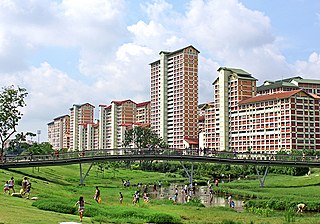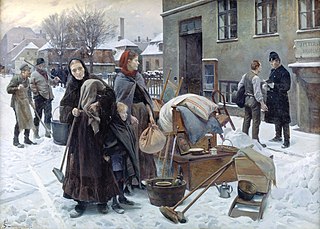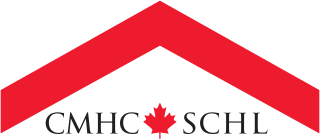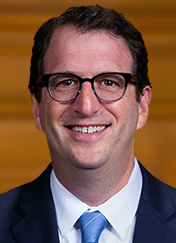Related Research Articles

Public housing is a form of housing tenure in which the property is usually owned by a government authority, either central or local. Although the common goal of public housing is to provide affordable housing, the details, terminology, definitions of poverty, and other criteria for allocation vary within different contexts.
The Low-Income Housing Tax Credit is a dollar-for-dollar tax credit in the United States for affordable housing investments. It was created under the Tax Reform Act of 1986 (TRA86) and gives incentives for the utilization of private equity in the development of affordable housing aimed at low-income Americans, with affordability restrictions on the properties expiring 15-30 years later. LIHTC accounts for the majority of all newly created affordable rental housing in the United States today. The maximum rent that can be charged for designated affordable units is based on Area Median Income (AMI), and over 50% of residents in LIHTC properties are considered Extremely Low-Income. The credits are also commonly called Section 42 credits in reference to the applicable section of the Internal Revenue Code. The tax credits are more attractive than tax deductions as the credits provide a dollar-for-dollar reduction in a taxpayer's federal income tax, whereas a tax deduction only provides a reduction in taxable income. The "passive loss rules" and similar tax changes made by TRA86 greatly reduced the value of tax credits and deductions to individual taxpayers. Less than 10% of current credit expenditures are claimed by individual investors.

Eviction is the removal of a tenant from rental property by the landlord. In some jurisdictions it may also involve the removal of persons from premises that were foreclosed by a mortgagee.

Canada Mortgage and Housing Corporation is Canada's federal crown corporation responsible for administering the National Housing Act, with the mandate to improve housing by living conditions in the country.
Subsidized housing is government sponsored economic assistance aimed towards alleviating housing costs and expenses for impoverished people with low to moderate incomes. In the United States, subsidized housing is often called "affordable housing". Forms of subsidies include direct housing subsidies, non-profit housing, public housing, rent supplements/vouchers, and some forms of co-operative and private sector housing. According to some sources, increasing access to housing may contribute to lower poverty rates.

Toronto Community Housing Corporation (TCHC) is a public housing agency in Toronto, Ontario. It is the largest social housing provider in Canada with over 58,000 units across 2,100 buildings and approximately 105,000 residents. It is the second-largest housing provider in North America, behind the New York City Housing Authority.

Public housing in Puerto Rico is a subsidized system of housing units, mostly consisting of housing projects, which are provided for low-income families in Puerto Rico. The system is mainly financed with programs from the US Department of Housing and Urban Development (HUD) and the US Department of Agriculture USDA Rural Development. As of 2020, there were 325 public housing developments in Puerto Rico.

The Oklahoma Housing Finance Agency (OHFA) is a non-profit organization which serves the people of Oklahoma by offering affordable housing resources, including loans and rent assistance. OHFA was created in 1975 when Governor of Oklahoma David L. Boren approved the agency's first trust indenture. OHFA is a public trust with the State of Oklahoma as the beneficiary. The Trust was established to better the housing stock and the housing conditions in the State of Oklahoma and administers the Section 8 housing program along with other housing programs for the State.
Government sponsored Student Loans in Canada was designed to help post-secondary students pay for their education in Canada. The federal government funds the Canada Student Loan Program (CSLP) and the provinces may fund their own programs or be integrated with the CSLP. In addition, Canadian banks offer commercial loans targeted for students in professional programs.
Rent regulation in New York is a means of limiting the amount of rent charged on dwellings. Rent control and rent stabilization are two programs used in parts of New York state. In addition to controlling rent, the system also prescribes rights and obligations for tenants and landlords.
Public housing policies in Canada includes rent controls, as well as subsidized interest rates and grants. Early public housing policy in Canada consisted of public-private lending schemes which focused on expanding home ownership among the middle class. The first major housing initiative in Canada was the Dominion Housing Act of 1935, which increased the amount of credit available for mortgage loans.
The Family Eviction Prevention Supplement was created by the New York City Human Resources Administration in May 2005 as a program to help prevent evictions of families on welfare shelter. It provides additional housing assistance to Cash Assistance (CA) eligible families with children, above and beyond the CA shelter amount.
Non-profit housing developers build affordable housing for individuals under-served by the private market. The non-profit housing sector is composed of community development corporations (CDC) and national and regional non-profit housing organizations whose mission is to provide for the needy, the elderly, working households, and others that the private housing market does not adequately serve. Of the total 4.6 million units in the social housing sector, non-profit developers have produced approximately 1.547 million units, or roughly one-third of the total stock. Since non-profit developers seldom have the financial resources or access to capital that for-profit entities do, they often use multiple layers of financing, usually from a variety of sources for both development and operation of these affordable housing units.
Affordable housing in Canada is housing that is deemed affordable to those with a median household income in Canada.

Howard County Housing is the umbrella organization for the Howard County Department of Housing and Community Development and the Howard County Housing Commission. The Department is Howard County Government’s housing agency, and the Commission is a public housing authority and non-profit. Both have boards that meet monthly.
The Rental Assistance Demonstration is a federal housing program that was enacted as part of the Consolidated and Further Continuing Appropriations Act, 2012, and is administered by the U.S. Department of Housing & Urban Development (HUD). Broadly, the purpose of the Rental Assistance Demonstration is to provide a set of tools to address the unmet capital needs of deeply affordable, federally assisted rental housing properties in order to maintain both the viability of the properties and their long-term affordability. It also simplifies the administrative oversight of the properties by the federal government. Specifically, RAD authorizes the conversion of a property's federal funding from one form to another, where the initial form presents structural impediments to private capital investment and the new form is not only familiar to lenders and investors but, since its enactment in 1974, has leveraged billions in private investment for the development and rehabilitation of deeply affordable rental housing.

Eviction in the United States refers to the pattern of tenant removal by landlords in the United States. In an eviction process, landlords forcibly remove tenants from their place of residence and reclaim the property. Landlords may decide to evict tenants who have failed to pay rent, violated lease terms, or possess an expired lease. Landlords may also choose not to renew a tenant's lease, however, this does not constitute an eviction. In the United States, eviction procedures, landlord rights, and tenant protections vary by state and locality. Historically, the United States has seen changes in domestic eviction rates during periods of major socio-political and economic turmoil—including the Great Depression, the 2008 Recession, and the COVID-19 pandemic. High eviction rates are driven by affordable housing shortages and rising housing costs. Across the United States, low-income and disadvantaged neighborhoods have disproportionately higher eviction rates. Certain demographics—including low income renters, Black and Hispanic renters, women, and people with children—are also at a greater risk of eviction. Additionally, eviction filings remain on renters' public records. This can make it more difficult for renters to access future housing, since most landlords will not rent to a tenant with a history of eviction. Eviction and housing instability are also linked to many negative health and life outcomes, including homelessness, poverty, and poor mental and physical health.

Affordable housing is housing that is deemed affordable to those with a median household income as rated by the national government or a local government by a recognized housing affordability index. A general rule is no more than 30% of gross monthly income should be spent on housing, to be considered affordable for the challenges of promoting affordable housing varies by location.

Dean E. Preston is an American attorney and member of the San Francisco Board of Supervisors. He founded Tenants Together, a California tenant advocacy organization. In November 2019, Preston won a special election to finish Mayor London Breed's term on the Board of Supervisors, defeating incumbent Vallie Brown to represent District 5. He was re-elected in the November 2020 election.
Just-Cause Eviction laws, also known as good-cause eviction, aim to provide tenants protection from unreasonable evictions, rent hikes, and non-renewal of lease agreements. These laws allow tenants to challenge evictions in court that are not for "legitimate" reasons. Generally, landlords oppose just-cause eviction laws due to concerns over profit, housing stock, and court cases.
References
- 1 2 Courtney Dickson (22 February 2019). "B.C. budget promises $10M for province-wide rent bank". CBC. Retrieved 23 July 2019.
- ↑ Jerry Buckland, Chris Robinson, Brenda Spotton Visano (March 2018). Payday Lending in Canada in a Global Context: A Mature Industry with Chronic Challenges. Springer. p. 165. ISBN 9783319712130 . Retrieved 23 July 2019.
{{cite book}}: CS1 maint: multiple names: authors list (link) - 1 2 3 "Province of Manitoba | News Releases | Province Announces $5.6-Million Rent Bank to Protect Families at Risk of Eviction". Province of Manitoba. Retrieved 2021-03-29.
- ↑ "Toronto rent bank". Nipost.
- ↑ "Facing Eviction? Behind on your Rent? The Rent Bank Can Help". FMTA. Retrieved 2021-03-29.
- 1 2 "Toronto Rent Bank". torontorentbank.ca. Retrieved 2021-03-29.
{{cite web}}: CS1 maint: url-status (link) - ↑ "About BC Rent Bank". BC Rent Bank. Retrieved 2021-03-29.
- ↑ "Find a Rent Bank Location". BC Rent Bank. Retrieved 2021-03-29.